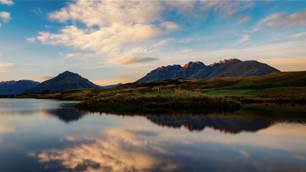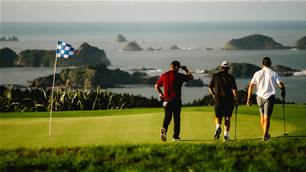New Zealand’s largest city, Auckland, is many things.
The Carrington Estate is a grand property occupying 3,000 acres of stunning seaside land on the Karikari Peninsula – about 80 minutes’ drive north of Kauri Cliffs – and is home to a winery, luxury resort and New Zealand’s northernmost golf course.
The highly rated course lies between the sweeping ocean views to the north and west, and hillside vineyards to the east. You might suspect this is a links layout given its oceanside location, but it is not. It is surprisingly more like an inland parkland course with large naturally occurring water hazards and a rolling landscape dictating the flow of holes.
Developed by American investment banker Paul Kelly, Carrington was extensively remodelled by designer Matt Dye and opened for play in December 2003. Dye – a third generation member of the world-renowned Dye family of golf course designers, having followed the family tradition established by grandfather Paul, his late father Roy and his uncle, Pete Dye – began his own design business in 2002. Carrington was his first solo project.
The layout covers beautiful land, where the views, especially from the clubhouse, towards the 15-metre-high sand dunes backing Karikari Beach and Great Exhibition Bay, are superb.

The natural contours of the land and the length of the layout – stretched to a 6,417-metre, par-72, from the tips – combine to create a stern challenge for better players. Casual players are able play from two other teeing options that present a less demanding length.
While the length adds to the course’s bite, especially on windy days of which there are many, it is some of Carrington’s short holes that will impress. The 301-metre par-4 5th is a wonderfully strategic hole. The fairway cascades down dramatically from tee-to-green and, depending on the wind direction, you can hit any club from a driver to a mid-iron to find a plateau en route to the putting surface.
The 6th hole, a 350-metre par-4, and the par-3 7th both bring water into play as they skirt a large lake. The 6th hole demands a tee short to carry the lake for a short distance before finding a narrow stretch of fairway. Despite measuring 75 metres shorter than the longest par-4 on the layout, this slight dogleg left hole still rates as Carrington’s hardest.
At the following hole, the tee shot must carry the entire width of the lake to reach the green, which is two thirds surrounded by water. From the shortest tee it is but a lob wedge from 55 metres but from the tips a solid blow from 165 metres is needed to safely find the putting surface.
Once you have found your way to Carrington Estate, you should stay a while. The resort boasts beautifully appointed and spacious Lodge Rooms, as well as three-bedroom villas and luxury houses offering views over the course, vineyards and ocean.
Having reached New Zealand’s northernmost course, it was time to point the car south for a five-hour haul back to Auckland, a good nights’ sleep and a further three-hour drive the following day to the scenic Lake Taupo region and two highly acclaimed layouts.
Wairakei Golf + Sanctuary was built in 1970 by the New Zealand government’s Tourist Hotel Corporation as part of its plan to attract international visitors, and golfers, to the Lake Taupo area.
Course designer Commander John Harris collaborated with five-time Open champion Peter Thomson and then U.S Tour player, Mike Wolveridge, on the project. It would become Thomson and Wolveridge’s first design project and they returned to upgrade the layout in 1997.
Wairakei has since matured into a visually striking and challenging layout. Set in a valley surrounded by pine forest covered mountains, the layout is immaculately presented and complements a superb design.
The terrain becomes more dramatic away from the clubhouse as the holes wind across, up and down the foothills, while the bunkering is not overdone and strategically placed. All the greenside bunkers are steep faced and lined with the trunks of native punga ferns.
This course is also an incredible wildlife sanctuary. A two-metre high fence was constructed around the course’s boundary to create a predator-free environment and today ducks, pheasants, takahe, deer and New Zealand’s national bird, the kiwi, now thrive.
Wairakei’s nearest golfing neighbour is arguably one of the finest Jack Nicklaus ever designed.
The Kinloch Club – about 20 minutes’ drive from the tourist town of Taupo – is a links style layout that is a real departure from Nicklaus’ trademark designs. Instead of the American parkland style course he has taken around the globe, Nicklaus aimed to create a Scottish links. The bunkering is rugged and varies greatly in shape, depth and size, while the rolling fairways of the front nine become more dramatic in their elevation change.
The course, which opened all 18 holes for play in December 2007, is laid out beneath a steep cattle covered range and it is easy to see Nicklaus has tried to reflect the rugged nature of the range into his creation.
There are several holes that will live long in the memory – the 5th and 6th are two dynamic short par-4s, while the 512-metre 8th has gained a reputation for being one of the best par-5s in New Zealand. The driving zone is flanked by sand and then the fairway splits in two providing a high and low route to the green, which is quite wide but only 26 metres at its deepest.

On the back nine, the par-4 13th is an absolute gem, as is the par-3 17th which is arguably the toughest of Kinloch’s one-shotters as it calls for a long shot to a green that is protected by a bunker left and features steep drop-off slopes short, long and right.
Having come this far there was no turning back now and I quite happily pushed on knowing the next course on my hit list was the Tom Doak-designed Cape Kidnappers, some three hours’ drive away on the coast just south of Hawkes Bay.
Related Articles

Take your golf game to the edge of the world in New Zealand

Touring New Zealand: The complete golfing package













